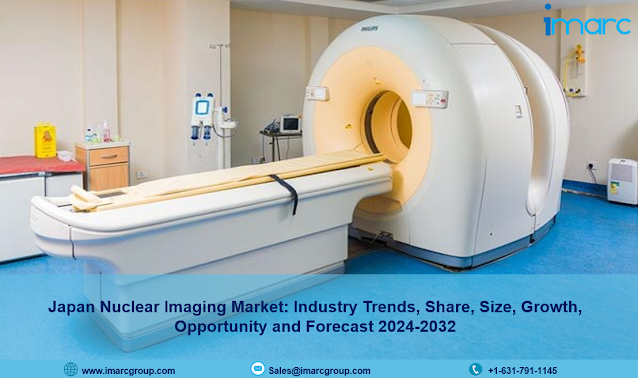Japan Nuclear Imaging Market Report 2024, Industry Trends, Size and Forecast Till 2032
IMARC Group's report titled "Japan Nuclear Imaging Market: Industry Trends, Share, Size, Growth, Opportunity and Forecast 2024-2032", offers a comprehensive analysis of the industry, which comprises insights on the Japan nuclear imaging market report. The market is projected to exhibit a growth rate (CAGR) of 4.24% during 2024-2032.
Factors Affecting the Growth of the Japan Nuclear Imaging Industry:
- Rising Healthcare Demands:
The rising demand for effective healthcare services among the masses is impelling the growth of the market in Japan. The prevalence of chronic diseases, such as cardiovascular disease, diabetes, and cancer, is increasing in Japan. Nuclear imaging techniques are essential for diagnosing and monitoring these conditions, leading to a higher demand for such services. Nuclear imaging helps clinicians plan treatments effectively. Furthermore, as more patients require treatment, precise imaging becomes crucial to ensure that interventions are targeted and successful.
- Increasing Focus Cancer Diagnosis and Treatment:
Early detection of cancer is essential for successful treatment outcomes. Nuclear imaging techniques, such as positron emission tomography (PET) scans, can identify cancerous lesions at an early stage, often before they are visible in conventional imaging. Nuclear imaging is instrumental in staging cancer and assessing whether it has spread to other parts of the body. This information is vital for treatment planning and prognosis. Nuclear imaging allows oncologists to monitor how well a patient is responding to cancer treatment. Changes in tumor activity can be tracked over time, helping to adjust treatment strategies as needed.
- Technological Advancements:
Advances in detector technology and image processing software are leading to higher- Advances in detector technology and image processing software are leading to higher-resolution nuclear images. This allows for more precise and detailed diagnostic information, improving the accuracy of disease detection and treatment planning. Combining nuclear imaging with other imaging modalities like computed tomography (CT) or magnetic resonance imaging (MRI) is becoming increasingly common. This fusion of technologies provides comprehensive diagnostic information and improves the accuracy of localization and characterization of abnormalities. Advanced software tools enable quantitative analysis of nuclear imaging data. This allows for a more objective and reproducible assessment of disease progression and treatment response, particularly in oncology.
For an in-depth analysis, you can refer sample copy of the report: https://www.imarcgroup.com/japan-nuclear-imaging-market/requestsample
Japan Nuclear Imaging Market Report Segmentation:
By Product:
- Equipment
- Radioisotope
- SPECT Radioisotopes
- Technetium-99m (TC-99m)
- Thallium-201 (TI-201)
- Gallium (Ga-67)
- Iodine (I-123)
- Others
- PET Radioisotopes
- Fluorine-18 (F-18)
- Rubidium-82 (RB-82)
- Others
Based on the product, the market has been segregated into equipment and radioisotope (SPECT radioisotopes (technetium-99m (TC-99m), thallium-201 (TI-201), gallium (Ga-67), iodine (I-123), and others and PET radioisotopes (fluorine-18 (F-18), rubidium-82 (RB-820 and others).
By Application:
- SPECT Applications
- Orthopedics
- Thyroid
- Cardiology
- Others
- PET Applications
- Oncology
- Cardiology
- Neurology
- Others
On the basis of the application, the market has been segmented into SPECT applications (orthopedics, thyroid, cardiology, and others) and PET applications (oncology, cardiology, neurology and others).
Regional Insights:
- Kanto Region
- Kansai/Kinki Region
- Central/ Chubu Region
- Kyushu-Okinawa Region
- Tohoku Region
- Chugoku Region
- Hokkaido Region
- Shikoku Region
Region-wise, the market has been divided into Kanto region, Kansai/Kinki region, Central/ Chubu region, Kyushu-Okinawa region, Tohoku region, Chugoku region, Hokkaido region, and Shikoku region.
Japan Nuclear Imaging Market Trends:
Ongoing research and development (R&D) efforts are driving the creation of more efficient and cost-effective nuclear imaging systems. This fuels market growth as healthcare facilities look to upgrade their equipment. Apart from this, the increasing awareness among both healthcare professionals and the general public about the benefits of nuclear imaging is leading to greater acceptance and utilization of these techniques. The implementation of the stringent regulatory framework for medical devices and imaging technologies, ensuring patient safety and quality standards is supporting the market growth in the country.
Note: If you need specific information that is not currently within the scope of the report, we will provide it to you as a part of the customization.




コメント
コメントを投稿